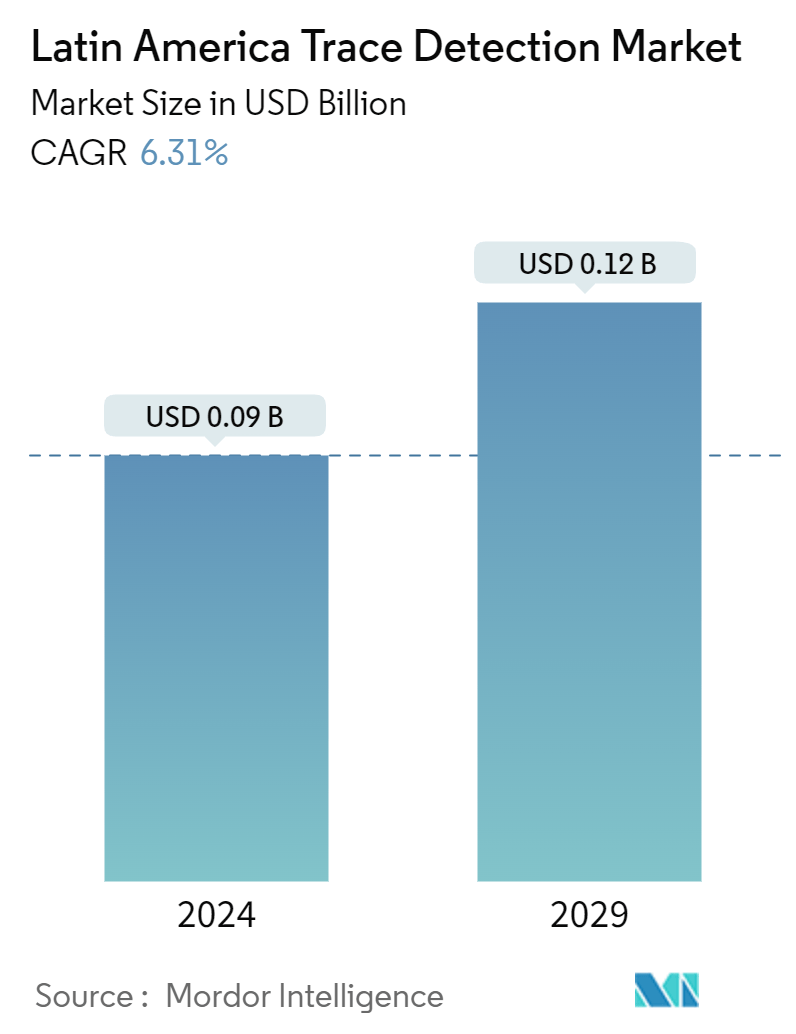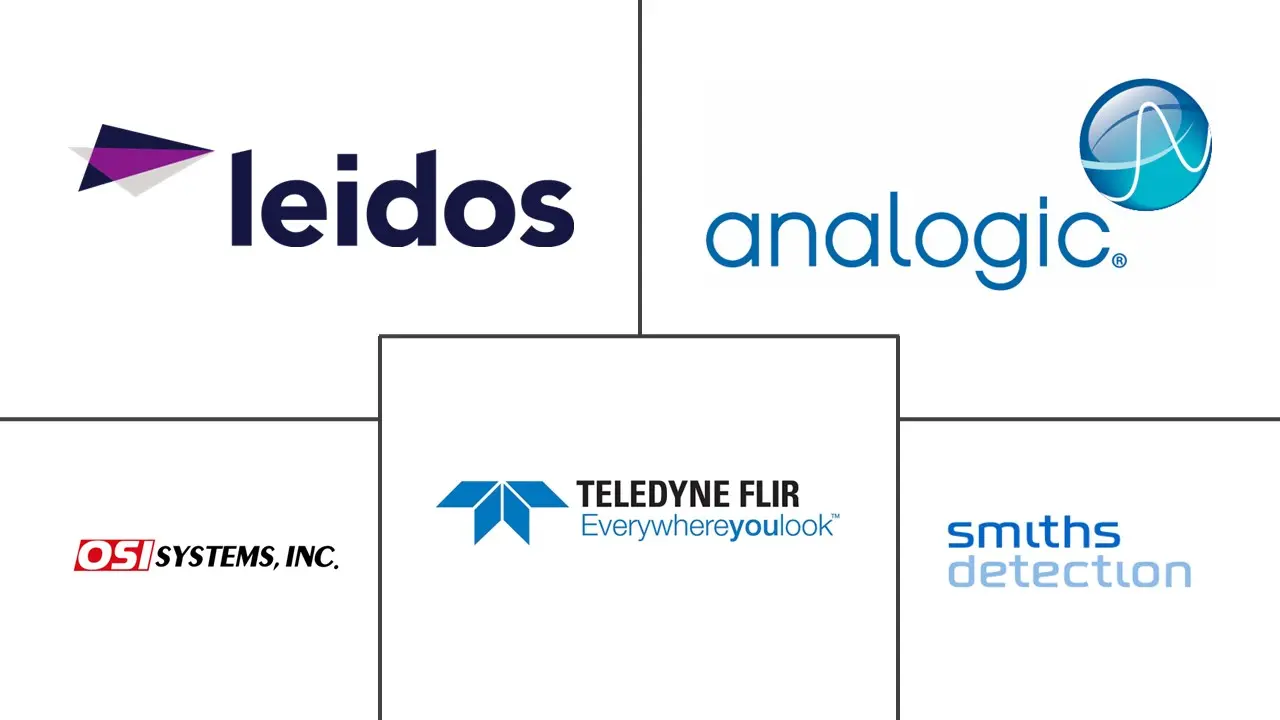
| Study Period | 2022 - 2029 |
| Base Year For Estimation | 2023 |
| Forecast Data Period | 2024 - 2029 |
| Market Size (2024) | USD 0.09 Billion |
| Market Size (2029) | USD 0.12 Billion |
| CAGR (2024 - 2029) | 6.31 % |
| Market Concentration | Medium |
Major Players
*Disclaimer: Major Players sorted in no particular order |
Latin America Trace Detection Market Analysis
The Latin America Trace Detection Market size is estimated at USD 0.09 billion in 2024, and is expected to reach USD 0.12 billion by 2029, growing at a CAGR of 6.31% during the forecast period (2024-2029).
- The identifiable situations in which a threat has been responded to tend to create a complicated passenger experience. Regarding security processes, the need for more secure transportation is growing, and this has transformed railway and other transport in recent decades, driving the trace detection market in Latin America.
- Security concerns have been a significant issue in Latin America. Owing to growing terrorist activity in the region, governments and private enterprises have invested massive amounts of money in security checks and surveillance. These concerns have been raised in infrastructure, transportation, and other security-critical places with a potential risk of terrorist attacks.
- The region experienced an increase in the trafficking of substances, such as cocaine and heroin, which is expected to impact the growth of the trace detection market positively, as devices/systems may be implemented to offer protection from the illegal movement of drugs. For instance, at the beginning of 2023, police in Brazil intercepted 125 kilos of cocaine in Santos Port. These trends are expected to heavily impact the growth of the adoption of technologies, such as terahertz technologies in the region, over the forecast period.
- Many regional city governments focus on adopting security screening products for high-security applications, namely secure city programs and critical infrastructure protection. Moreover, the emphasis is increasing on developing innovative cities in emerging economies.
- In February 2024, Autoclear announced the commercial launch of AI Threat Assist, an AI-powered threat detection tool that helps to identify concealed guns, knives, and other concealed objects such as backpacks, handbags, and other items being inspected using Autoclear's X-ray security scanners.
Latin America Trace Detection Industry Segmentation
Trace detection refers to the process of detecting or identifying minute or trace amounts of a substance or material. Trace detection involves collecting samples from surfaces, objects, or the environment and analyzing them using specialized equipment or methods to detect the target substance at very low concentrations.
The Latin American trace detection market is segmented by type (explosive and narcotics), product (handheld, portable/movable, and fixed), end-user industry (commercial, military and defense, law enforcement, ports and borders, public safety, and other end-user industries), and country (Mexico, Brazil, Argentina, and Rest of Latin America). The report offers the market size and forecasts for all the above segments in value (USD).
| Explosive |
| Narcotics |
| Handheld |
| Portable/Movable |
| Fixed |
| Commercial |
| Military and Defense |
| Law Enforcement |
| Ports and Borders |
| Public Safety |
| Other End-user Industries |
| Mexico |
| Brazil |
| Argentina |
| Colombia |
| Chile |
Latin America Trace Detection Market Size Summary
The Latin America trace detection market is poised for growth, driven by increasing security concerns and the need for enhanced safety measures across various sectors. The region has witnessed a rise in terrorist activities and drug trafficking, prompting significant investments in security infrastructure by both governments and private entities. This has led to a heightened demand for advanced trace detection technologies, particularly in transportation and critical infrastructure. The adoption of smart city initiatives and urban development projects further fuels the market, as governments seek to integrate advanced security solutions to protect urban areas. The market is characterized by a semi-consolidated landscape, with key players like Teledyne FLIR LLC, OSI Systems Inc., and Smiths Detection Group Ltd. leading the charge in developing innovative detection systems.
The commercial segment of the trace detection market is expected to experience substantial growth, driven by the increasing need for security in the aviation sector and the rising incidents of terrorism and illegal arms transfers. The demand for explosive trace detectors is on the rise, as these systems are crucial for identifying narcotics and explosive materials quickly and efficiently. The market's expansion is further supported by the growing air traffic and the implementation of stringent security regulations at airports. Recent developments, such as the deployment of advanced cargo inspection systems and the introduction of AI-powered threat detection tools, highlight the ongoing advancements in trace detection technologies. These innovations are set to enhance security measures across Latin America, addressing the region's unique challenges and contributing to the market's growth trajectory.
Latin America Trace Detection Market Size - Table of Contents
1. MARKET DYNAMICS
-
1.1 Market Drivers
- 1.1.1 Upsurge in Terrorist Activities Across the Region
- 1.1.2 Growing Government Investments in Security Infrastructure
- 1.1.3 Increasing Government Guidelines for Aviation Security Screening
-
1.2 Market Restraints
- 1.2.1 High Initial Cost of Installation and Subsequent Maintenance Costs
- 1.2.2 Technological Limitations and the Lack of Trained Personnel
2. MARKET SEGMENTATION
-
2.1 By Type
- 2.1.1 Explosive
- 2.1.2 Narcotics
-
2.2 By Product
- 2.2.1 Handheld
- 2.2.2 Portable/Movable
- 2.2.3 Fixed
-
2.3 By End-user Industry
- 2.3.1 Commercial
- 2.3.2 Military and Defense
- 2.3.3 Law Enforcement
- 2.3.4 Ports and Borders
- 2.3.5 Public Safety
- 2.3.6 Other End-user Industries
-
2.4 By Country***
- 2.4.1 Mexico
- 2.4.2 Brazil
- 2.4.3 Argentina
- 2.4.4 Colombia
- 2.4.5 Chile
Latin America Trace Detection Market Research FAQs
How big is the Latin America Trace Detection Market?
The Latin America Trace Detection Market size is expected to reach USD 0.10 billion in 2025 and grow at a CAGR of 6.31% to reach USD 0.13 billion by 2030.
What is the current Latin America Trace Detection Market size?
In 2025, the Latin America Trace Detection Market size is expected to reach USD 0.10 billion.


